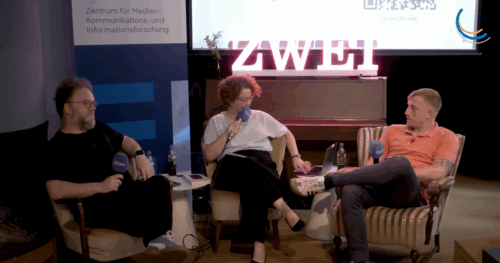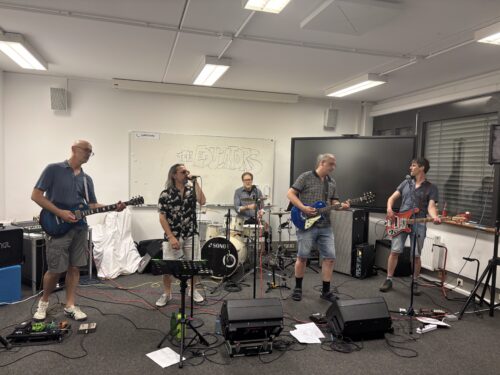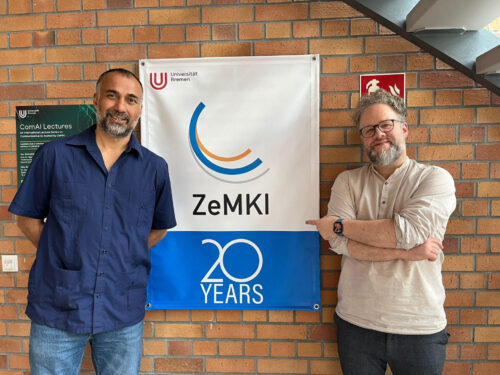ComAI Lectures - Alle Vorträge im Wintersemester 2025/26
ZeMKI, Zentrum für Medien-, Kommunikations- und Informationsforschung
Das Zentrum für Medien-, Kommunikations- und Informationsforschung (ZeMKI) ist eine von sieben Zentralen Wissenschaftlichen Einrichtungen der Universität Bremen und gehört zu den wichtigen europäischen Einrichtungen zur Erforschung von Fragen des Medien- und Kommunikationswandels an der Schnittstelle von Kultur- und Sozialwissenschaften einerseits und Technikwissenschaften andererseits.
Neuigkeiten

Sandra Kero im Interview im COSMO-Programm des WDR
Am 22. Juli gibt ZeMKI-Mitglied Sandra Kero im COSMO-Programm des WDR ein Interview für den Beitrag „Beauty Backlash – Was das Comeback traditioneller Schönheitsideale mit dem erstarkenden Rechtspopulismus zu tun hat“.
23. Juli 2025

KI an Hochschulen: Einblicke in aktuelle Herausforderungen und Perspektiven
Vom 21. bis 23. Juli 2025 findet in Münster das erste KI-Lab des Hochschulforums Digitalisierung (HFD) statt. Mit dabei ist auch das ComAI-Teilprojekt „Kommunikative KI für Lehren und Lernen“, das das KI-Lab wissenschaftlich begleitet.
18. Juli 2025

Das ZeMKI auf der IAMCR 2025
Die IAMCR findet vom 13. bis 17. Juli 2025 in Singapur statt. Das diesjährige Thema lautet: „Communicating Environmental Justice: Many Voices, One Planet“.
11. Juli 2025

Neue Publikation analysiert globale Zukunftsvorstellungen zu KI
Wie wird die Zukunft von Künstlicher Intelligenz (KI) in unterschiedlichen Ländern gedacht – und wer prägt diese Vorstellungen? Dieser Frage geht eine neue Studie von ZeMKI-Mitgliedern Vanessa Richter und Christian Katzenbach nach.
10. Juli 2025

Mediengespräch mit Hubtertus Koch auf YouTube
Das vollständige Mediengespräch mit Journalist, Filmemacher und Autor Hubertus Koch zum Thema „Journalismus auf Social Media: Enttäuschung, Ermüdung oder große Chancen?“ vom 19. juni 2025 ist nun auf YouTube verfügbar.
8. Juli 2025

Andreas Hepp über Zukunftsvisionen auf der Expo 2025 in Osaka
Unter dem Titel „Expo in Osaka: Holzring statt Glaskugel“ analysiert Andreas Hepp in der taz die auf der Expo 2025 präsentierten Zukunftsszenarien – von KI-gesteuerten Lebenswelten bis hin zu lokal verankerten, nachhaltigen Projekten.
5. Juli 2025

ZeMKI-Sommerfest 2025
- Datum: 2. July 2025
- Ort: Bremen
Bei strahlendem Sonnenschein und hochsommerlichen Temperaturen feierte das ZeMKI am 2. Juli 2025 sein traditionelles Sommerfest am Standort in der Linzer Straße.
3. Juli 2025

Joyojeet Pal als ZeMKI-Fellow in Bremen
Das Zentrum für Medien-, Kommunikations- und Informationsforschung (ZeMKI) der Universität Bremen begrüßt im Juni 2025 Medien- und Technologieexperten Joyojeet Pal als Visiting Research Fellow.
2. Juli 2025

